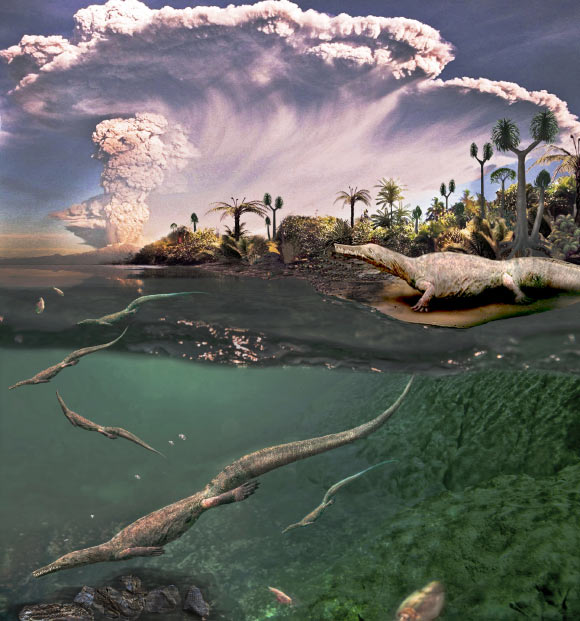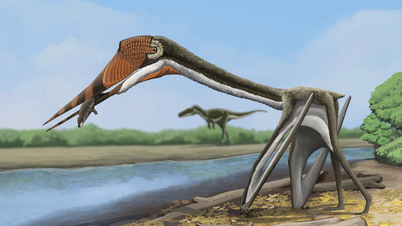(NLDO) - Mesosaur monsters were rampant tens of millions of years before the earliest dinosaurs appeared on Earth.
According to Sci-News, paleontologists have discovered large skulls and some bones of a new species of Mesosaur monster.
The new species is twice the size of any previously found mesosaur, preserved in Diapsid rocks in the Mangrullo Formation of Uruguay and the Iratí Formation of Brazil.

Mesosaur Monster - Photo illustration: Roman Yevseyev/Graciela Piñeiro
Dr Graciela Piñeiro from the University of the Republic (Uruguay), who led the research team, described the Mesosaur monster as a small to medium-sized aquatic reptile with an elongated body and a tail longer than the rest of the body.
Their skulls are characterized by long snouts, very thin skull bones, and many needle-like teeth.
This family of monsters existed on Earth about 299-270 million years ago, from the early to mid-Cenozoic period.
As such, they are much older than dinosaurs, whose earliest dinosaurs only emerged during the later Triassic period (251-200 million years ago), before becoming the dominant monsters of the earth during the Jurassic and Cretaceous periods that followed.
They are identified by scientists as an "intermediate dinosaur", so learning about them could provide valuable clues about the amazing evolutionary process that helped create the dinosaur world.
The newly discovered Mesosaur fossils in South America also include individuals at different stages of development, from fetuses to juveniles and adults, making this collection important.
Previously found mesosaur specimens averaged 70 cm in length. The skull alone of this new species is 15-20 cm long, while the total body length is estimated at 1.5 - 2.5 m.
They may be the size of small modern crocodiles, but in the ancient Diplodocus world, that size was enough to make them giant monsters.
Like other Mesosaurs, these giant Mesosaurs are thought to have disappeared during the troubled times that occurred in the ancient supercontinent Gondwana. Today's South America was part of Gondwana.
It was a period of intense volcanic activity, devastating droughts, and widespread desertification in the mid-Cenozoic, according to a paper published in the journal Fossil Studies.
Source: https://nld.com.vn/phat-hien-quai-vat-mesosaur-lon-nhat-tung-duoc-biet-den-19625010710503312.htm


![[Photo] General Secretary To Lam begins official visit to Russia and attends the 80th Anniversary of Victory over Fascism](https://vphoto.vietnam.vn/thumb/1200x675/vietnam/resource/IMAGE/2025/5/8/5d2566d7f67d4a1e9b88bc677831ec9d)
![[Photo] President Luong Cuong presents the decision to appoint Deputy Head of the Office of the President](https://vphoto.vietnam.vn/thumb/1200x675/vietnam/resource/IMAGE/2025/5/8/501f8ee192f3476ab9f7579c57b423ad)

![[Photo] General Secretary concludes visit to Azerbaijan, departs for visit to Russian Federation](https://vphoto.vietnam.vn/thumb/1200x675/vietnam/resource/IMAGE/2025/5/8/7a135ad280314b66917ad278ce0e26fa)
![[Photo] National Assembly Chairman Tran Thanh Man chairs the meeting of the Subcommittee on Documents of the First National Assembly Party Congress](https://vphoto.vietnam.vn/thumb/1200x675/vietnam/resource/IMAGE/2025/5/8/72b19a73d94a4affab411fd8c87f4f8d)
![[Photo] Prime Minister Pham Minh Chinh meets with the Policy Advisory Council on Private Economic Development](https://vphoto.vietnam.vn/thumb/1200x675/vietnam/resource/IMAGE/2025/5/8/387da60b85cc489ab2aed8442fc3b14a)







![[Video] Institute of Social Science Information celebrates 50th anniversary](https://vphoto.vietnam.vn/thumb/402x226/vietnam/resource/IMAGE/2025/5/8/541d6946f8a14ed3824d7a3edafc652c)















































![[Photo] Prime Minister Pham Minh Chinh talks on the phone with Singaporean Prime Minister Lawrence Wong](https://vphoto.vietnam.vn/thumb/402x226/vietnam/resource/IMAGE/2025/5/8/e2eab082d9bc4fc4a360b28fa0ab94de)































Comment (0)